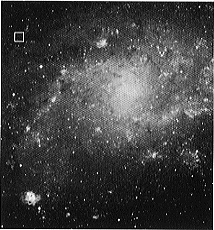

![[grid]](/lfs/tguide/image/4corners.gif) Infrared radiation is collected by the KAO telescope and focused onto a detector.
The detector has 60 infrared sensors arranged like this array. (The four corners
of the array do not have sensors.) Each sensor measures the radiation falling on
its area of the detector.
Infrared radiation is collected by the KAO telescope and focused onto a detector.
The detector has 60 infrared sensors arranged like this array. (The four corners
of the array do not have sensors.) Each sensor measures the radiation falling on
its area of the detector.

 Above left is an infrared image of the center of the M33 - Each little square in
the picture is called a "pixel." (picture element) It is difficult for the human
eye to identify in object with only 64 pixels. Try to identify the 64 pixel
image directly to the left.
Above left is an infrared image of the center of the M33 - Each little square in
the picture is called a "pixel." (picture element) It is difficult for the human
eye to identify in object with only 64 pixels. Try to identify the 64 pixel
image directly to the left.
![[1.]](/lfs/tguide/image/jupiter1.gif) 2.
2.![[2.]](/lfs/tguide/image/jupiter2.gif) 3.
3.![[3.]](/lfs/tguide/image/jupiter3.gif)

Can you read the image above? Back away and try again.
 Sizing up the field
Sizing up the field The Ring Nebula (to the left) is 70 arc seconds wide and is scaled in this photo to be the size that the KAO detector will see.
 Some objects like the M33 galaxy (to right), are much too large for the
detector. The white square in the photo shows the relative size of the IR
detector array. Astronomers will have to choose what part of the object to
observe. The entire galaxy is 60 arc minutes by 40 arc minutes. Draw ten
little boxes around the areas where you would collect data in M33.
Some objects like the M33 galaxy (to right), are much too large for the
detector. The white square in the photo shows the relative size of the IR
detector array. Astronomers will have to choose what part of the object to
observe. The entire galaxy is 60 arc minutes by 40 arc minutes. Draw ten
little boxes around the areas where you would collect data in M33.
At a wavelength of 100 microns, the array sees an area 3.5 arc minutes on a side. At 160 microns. the array covers 6 arc minutes on a side. If the box above is 2 arc minutes wide, draw a box that would show the field at I 00 microns and at 160 microns. Astronomers on the KAO will report which wavelengths they are measuring during the flight.
![]()